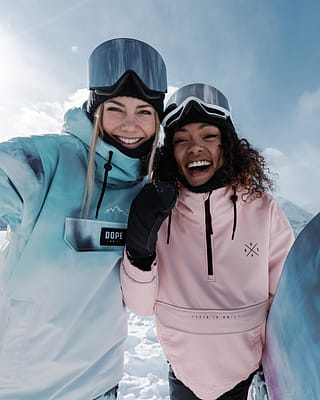Ski goggle lens color guide
Choosing the right goggle lens color can be a make-or-break decision. Go too dark in the wrong conditions, and you might as well be riding blindfolded. Wear a lens that’s too light and you’ll be blinded by the sun. But don’t worry, we’re here with our ski goggle lens color guide to help you out.

You’re buying a new pair of goggles… congrats! Hold on a sec, though. We know it’s tempting to pick the color lens that goes with your ski outfit or select the rad-looking mirror design over those see-through yellow tints. However, there’s more than meets the eye when it comes to ski goggles (pun fully intended).
You see, those various tints and colors filter light differently, affecting your visibility in different ways and different conditions. Some cut glare under intense sunshine while others boost contrast for you to identify variations in the terrain. Don’t worry, though, we’re here to help you figure out what’s what with our guide. And, when you're ready to find your perfect pair, dive into our full goggle lineup below.
How to choose between different lenses
What is VLT?

VLT stands for ‘Visible Light Transmission’. Measured in percentage, VLT is the amount of light that passes through your goggle lens and reaches your eyes. Basically, VLT helps indicate how ‘dark’ your goggles will be. So:
- Lower VLT ratings (such as 10% VLT) block more light, making them better for brighter, sunny conditions
- Higher VLT ratings (such as 70% VLT) let more light seep in, making them suited to cloudy or low-light conditions
It’s important to remember that light transmission and colors vary from brand to brand. Some brands put their own spin on VLT ratings, tints, and which goggles to wear in different conditions. So, check the exact product specs before committing.
Best lens colors for different conditions
Now let’s see how general VLT ratings and colors relate to skiing conditions. Oh, but before we do, you might also notice a lens ‘category’ on goggle product pages. These categories are part of the Protection Index and refer to the percentage of light not filtered out by the lens. Just like we mentioned earlier, these are general guidelines, and since every brand has its own take on VLT ranges and lens colors, it's always best to double-check the product specs.
Sunny conditions
Colors: Platinum, black, grey/silver, or heavy mirror
VLT range: Less than 25%
Category: 3 and 4
Wake up to a bluebird? The jackpot of all ski conditions needs a mirrored or dark-colored lens. That’s because these lenses filter bright light and boost contrast, so you experience reduced glare from the sun and less eye fatigue. With a bright-condition lens, you can focus on what’s ahead. And lap the mountain.
Partly cloudy and everyday conditions
Colors: Blue, green, red, rose/pink, gold
VLT range: 25%-50%
Category: 1 and 2
On days where it looks like clouds might follow the sun and vice versa, it’s best to reach for an all-purpose tint, such as greens, reds, and blues (typically primary colors, but not always). Known as everyday lenses, they handle a huge range of conditions from blue skies to overcast. So, you don’t have to worry about being unable to see if the sun temporarily disappears behind clouds, or you cruise under tree cover or on shaded slopes.
Cloudy or low-light conditions
Colors: Yellow, amber, light rose
VLT range: 50+%
Category: 1
Planning freshies in thick cloud or low-light conditions? It’s handy to choose a softer tint, such as yellow or light rose. And hey, we’ve heard it’s nice to see the world through rose-tinted lenses… These lens colors allow more light to pass through, often creating higher contrast and, in turn, enhancing your vision.That way, you can see, and avoid, those mountain dips and bumps on darker days.
Night skiing
Colors: Clear
VLT range: 80%+
Category: 0
Clear lenses often have a super-high VLT (such as 80% or higher). This makes them ideal for night skiing and mega cloudy days as they block virtually zero light without affecting tone or depth perception. Winner.
Interchangeable lenses vs. single lenses
Single lens
If you have your eye on one pair of goggles, it’s best to make sure the lens can handle most riding days and conditions. That means choosing an all-purpose, universal lens color, such as green, red, or blue.
Remember that, in general, the darker the lens tint (such as black and gray), the more suited those goggles are to bright conditions (as the VLT is lower, and so less light passes through the lens). On the flip side, the lighter the lens color, the better it is for cloudier, darker days. Of course, this isn’t a hard-and-fast rule, and some brands mix things up. Spotted the right VLT, but discovered multiple colors? This is when you now choose the lens tint based on your personal taste.
Interchangeable lenses
Feel you need one lens for sunshine and another for whiteouts? For more versatility, choose goggles with interchangeable lenses. This means you have one pair of goggles but can use multiple lenses, so you’re prepped for whatever Mother Nature and the snow gods throw at you.
Ride with a ‘main’ lens (typically best suited to sun) but switch to a cloudy or low-light lens when needed. And don’t worry, most brands make swapping your lenses super easy. The bonus? Spare lenses take up minimal space in your backpack, so bringing one along is a no-brainer.

FAQs
Are mirrored ski goggles better?
Mirrored ski goggles are a great choice for bright, sunny days. The reflective coating on the outer lens helps reduce glare and limit light transmission, giving your eyes a break when the sun’s out in full force. But mirrored doesn’t always mean dark. Thanks to advances in lens tech, many mirrored goggles now come with higher VLT ratings, making them totally suitable for cloudy or flat-light days too. In other words, it’s not the mirror that matters most – it’s the VLT.
Do you wear sunglasses under ski goggles?
Nope, it’s not recommended to wear sunglasses under ski goggles. Your ski goggles provide 100% UV protection, anti-glare vision, and act as a shield against wind, snow, and the sun’s rays. So, wearing sunglasses underneath will only mess with the fit, make your goggles feel super uncomfortable, and likely mean you can’t see much at all! If you need prescription sunglasses for better sight, look at over the glasses (OTG) goggles instead. These specialized goggles fit over the top of prescription glasses.
Wrapping up
Colored lenses enhance your vision in different ways, allowing you to see and shred the hill from peak to base. Now you can confidently browse for goggles and even advise your crew on the best lenses. In fact, you’re ready to become a goggle guru.
Have more questions about our goggles, VLT, or colored lenses? Reach out to our team via crew@dopesnow.com. Our crew is mega knowledgeable about products, tech, and all things snow. Plus, they love chatting with you guys, so you have everything you need for the best time on the mountain.
Related reading:


